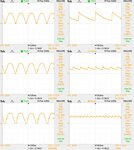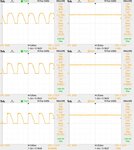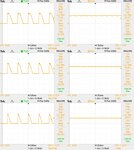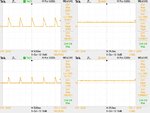muhibraza
Member level 1
Hello, I have implemented the following circuit but the expected output waveform is not there....

I am triggering the SCR at 1 degree and then gradually I increase the firing angle with increments of 15 degrees up till 150 degrees....I expected the average voltage to be maximum at 1 degree with an almost smooth waveform and minimum at 150 degrees.... as I increase the firing angle, the output average voltage should decrease proportionally and the values should be in descending order.... but this the not the case here....the output average voltage starts descending from around 45 degrees instead of 1 degree and the waveform from 1 degree to 30 degrees contains large ripples....Am I doing something wrong or is that supposed to be like that ? And what do I do in order to conduct maximum at lower angles and minimum at higher angles ? Please Help.
I am attaching the output waveforms that I recorded on 1,15,30,45,60,75,90,105,120,135 and 150º firing angles respectively (first row is on 1º, second row on 15º, third on 30º and so on)
the left ones are those without the capacitor in place, only the 50 Ohm resistor is present. And the right ones are those which were taken with capacitor in place (on the same firing angle)





I am triggering the SCR at 1 degree and then gradually I increase the firing angle with increments of 15 degrees up till 150 degrees....I expected the average voltage to be maximum at 1 degree with an almost smooth waveform and minimum at 150 degrees.... as I increase the firing angle, the output average voltage should decrease proportionally and the values should be in descending order.... but this the not the case here....the output average voltage starts descending from around 45 degrees instead of 1 degree and the waveform from 1 degree to 30 degrees contains large ripples....Am I doing something wrong or is that supposed to be like that ? And what do I do in order to conduct maximum at lower angles and minimum at higher angles ? Please Help.
I am attaching the output waveforms that I recorded on 1,15,30,45,60,75,90,105,120,135 and 150º firing angles respectively (first row is on 1º, second row on 15º, third on 30º and so on)
the left ones are those without the capacitor in place, only the 50 Ohm resistor is present. And the right ones are those which were taken with capacitor in place (on the same firing angle)



